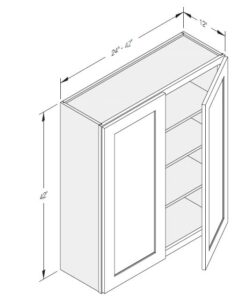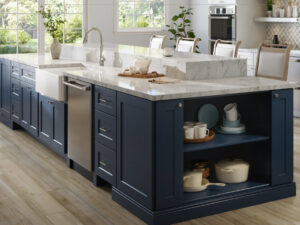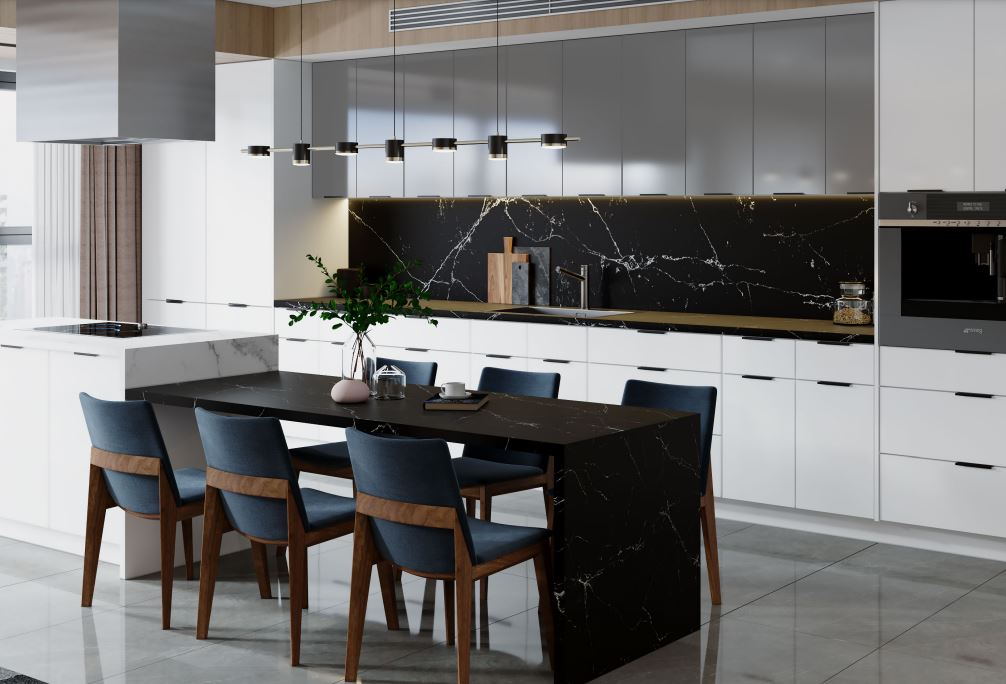Choosing the right hardware for your cabinets can greatly impact the aesthetic and functionality of your kitchen or bathroom. It requires a well-thought-out plan, taking into account several key factors.
Consider the Overall Style of the Space

When choosing hardware for your kitchen cabinets, a crucial first step is to consider the overarching style of the room where they’ll be placed. The design aesthetic you’re aiming for, whether it be modern, traditional, or something in between, will heavily influence your choice of hardware.
If you’re looking to create a modern, minimalist space, the “less is more” principle usually applies. Modern style often embraces a sleek and clean aesthetic, free from excessive ornamentation. Hardware choices that reflect this style are typically simple, streamlined, and geometric, featuring a great deal of straight lines and minimal detailing. Pulls and knobs in brushed nickel or chrome, for instance, can enhance the sense of sophistication and cleanliness that’s associated with modern design.
On the other hand, a traditional design aesthetic often incorporates a greater level of detail and ornate elements, paying homage to historical styles and designs. Traditional hardware choices can feature more intricate designs, like vintage glass or ceramic knobs, antique brass pulls, or fixtures with filigree detailing. These are reminiscent of past eras and can add an elegant, timeless quality to your space.
Then there’s the middle ground: contemporary or transitional styles. These design approaches are all about blending—taking elements from both ends of the spectrum to create a balanced, harmonious look. In these spaces, you may see a mix of both sleek, modern hardware and more detailed, traditional pieces. The hardware in transitional kitchens and bathrooms can vary significantly based on personal preferences and the specific blend of styles that you’re aiming to achieve.
In line with this, eclectic style offers another dimension. If you’re someone who enjoys mixing different periods and styles, eclectic style allows for a great deal of freedom and creativity. The key to achieving a balanced eclectic look is to create some level of cohesion or symmetry—either through repeating certain shapes, materials, or finishes in your hardware choices.
Another important aspect is the color scheme and materials used in your space. If you have a predominantly white kitchen with marble countertops, for example, brass or black hardware can add a striking contrast.
Remember, the aim is to ensure that your hardware enhances and complements the overall design of the space. It should feel like a natural extension of the aesthetic, tying together the room’s design elements and contributing to a unified, well-thought-out design.
Pay Attention to Function
The function of the cabinet hardware is equally as important as its aesthetic appeal. After all, the primary purpose of knobs and pulls is to assist in opening and closing doors and drawers.
Cabinet hardware comes in various sizes and styles, and the right choice will greatly contribute to the overall usability of your cabinets. For instance, if the cabinets are located in a high-traffic area of your home and will be used frequently, it’s essential to choose hardware that’s easy to grip and pull. Larger, sturdy knobs and pulls might be more suitable in this context, as they offer a comfortable grip and can withstand regular use without loosening or breaking.
In households with children or individuals with smaller hands, larger or longer handles could prove more practical. These are easier to grasp and can help prevent little hands from slipping. Similarly, in homes with elderly residents or those with mobility issues, easy-to-grip hardware that doesn’t require a lot of strength to use can make a significant difference.
Ergonomic designs are another consideration in terms of functionality. These designs are shaped to fit the natural contours of the hand, reducing discomfort and strain during use. For instance, pull handles that curve inward can be easier to grip and pull, particularly for those with arthritis or other joint issues.
You should also consider the material of the hardware. Smooth, non-porous materials like metal or ceramic are easy to clean and disinfect – a significant advantage in kitchens and bathrooms, where cleanliness is paramount.
Also, consider the mechanics of the hardware. For instance, soft-close hinges and slides can make your cabinets and drawers close gently and quietly, enhancing the overall user experience.
Remember that functionality doesn’t have to come at the expense of style. Many beautiful knobs and pulls are designed with comfort and ease of use in mind. By considering function as well as form, you can choose cabinet hardware that not only looks great but also makes your kitchen or bathroom more user-friendly.
The Finish
 The finish of your cabinet hardware is a crucial detail that can significantly impact the overall look and feel of your space. It adds depth and richness to your cabinets and can tie the room’s design together in subtle yet impactful ways.
The finish of your cabinet hardware is a crucial detail that can significantly impact the overall look and feel of your space. It adds depth and richness to your cabinets and can tie the room’s design together in subtle yet impactful ways.
The options for finishes are plentiful. Chrome and stainless steel are popular choices, offering a sleek and modern appeal. Their cool undertones and reflective surfaces can brighten up your space and give it a contemporary vibe. These finishes are also known for their durability and resistance to corrosion, making them practical for areas exposed to moisture like kitchens and bathrooms.
Oil-rubbed bronze, on the other hand, gives a deep, rich color that can add warmth and sophistication to your space. It’s ideal for traditional or rustic style spaces, adding an antiqued, time-worn charm. Similarly, brass is another traditional choice that adds warmth but with a touch of elegance. Its golden tones can create a more luxurious and upscale feel.
Brushed nickel and copper are other interesting finishes. Brushed nickel has a soft, matte look that can hide fingerprints and water spots, making it a practical choice for busy spaces. It also works well in a variety of styles, from traditional to contemporary. Copper, with its warm, reddish tones, can add a rustic or vintage feel and is particularly suited to farmhouse or Mediterranean-style spaces.
In choosing the right finish, you should consider the overall color scheme and style of your kitchen or bathroom. It’s important that the hardware finish complements the cabinet color, the countertop material, and the other fixtures in the space. For instance, if you have stainless steel appliances, matching your hardware finish can create a cohesive, streamlined look.
However, don’t be afraid to mix finishes if it suits your style. For instance, you could have chrome fixtures and oil-rubbed bronze hardware, creating a striking contrast that adds visual interest to your space. The key is to maintain balance and harmony among the different elements in the room.
It’s worth noting that finishes also have practical considerations. Some finishes show fingerprints, scratches, or wear more than others, and may require more frequent cleaning or care. Therefore, when making your decision, consider the level of maintenance you’re willing and able to provide.
Choosing the right finish is both an art and a science, requiring a balance of aesthetics, practicality, and your personal taste.
Related Post > 5 Countertops that Look Beautiful in a Blue Kitchen
Budget
Budget is a key factor in your decision-making process when it comes to selecting kitchen cabinets. The cost can vary significantly depending on various factors such as design, material, brand, and whether the hardware is mass-produced or custom-made.
On one end of the spectrum, you have hardware that can be purchased for just a few dollars per piece. These options are often mass-produced, made from less expensive materials, and feature more basic designs. They can be a good fit if you’re working with a tight budget or have a large number of cabinets to outfit.
On the other end, you have custom or designer hardware that can cost several hundreds of dollars per piece. This hardware is often made from high-quality materials, features unique or intricate designs, and can offer a high-end look and feel. While the upfront cost is higher, these pieces can add significant value and character to your space.
It might be tempting to save money by opting for cheaper alternatives, but remember that cabinet hardware is a long-term investment. It should not only reflect your personal style and preferences but also be durable enough to withstand daily use. Cheaper hardware might not hold up as well over time, potentially leading to higher costs down the road for replacements or repairs.
When setting your budget, consider both the upfront cost and the long-term value. High-quality hardware can last for many years and elevate the look of your kitchen or bathroom. Also, remember that this is a small detail that can make a big impact on the overall design of your space. So, it’s worth investing a little more if it means getting a look you love and hardware that will stand the test of time.
Consider a balance between cost and quality, as well as style and functionality. This will ensure you get the best value for your investment and enjoy your choice of hardware for years to come. Don’t hesitate to shop around, compare prices, and read reviews to ensure you’re getting the best deal for your budget.
Ultimately, choose the best cabinet hardware you can afford, keeping in mind that this small detail can significantly contribute to your home’s aesthetic, functionality, and overall value.
Scale & Positioning
The scale and positioning of your cabinet hardware, while it might seem a minor detail, plays a substantial role in the overall look and functionality of your cabinets. The compatibility between your cabinets and their hardware, in terms of size and positioning, is critical in ensuring not only a visually pleasing result, but also efficient usability.
To start with the scale, oversized hardware can make a bold statement, adding a touch of drama to large, paneled cabinets. It provides a strong, visual anchor, making the cabinets more noticeable and significant in the room’s design. However, this must be done carefully, as too large hardware can also overpower the cabinets, throwing the entire room off-balance.
In contrast, small or delicate hardware is generally more suitable for small or upper cabinets. These less imposing pieces can help maintain a light, airy feel, especially in small spaces where too large hardware might feel overwhelming. However, be careful that they’re not too small to grip comfortably, particularly if the cabinets or drawers are heavy.
In terms of positioning, the ‘correct’ placement can vary based on a few factors, such as the type of cabinet, the style of the kitchen or bathroom, and personal preference. Traditional placement would have knobs located in the corner of the cabinet door and drawer pulls located in the center of the drawer front. However, for a more modern look, you could place the knobs and pulls towards the top or bottom of the door, creating a minimalistic, streamlined look.
Functionality is another important consideration when it comes to hardware placement. For tall, upper cabinets, lower-placed hardware might make it easier to reach and open. For lower cabinets or deep drawers, hardware placed higher might reduce the need to bend down too much. Additionally, the positioning should facilitate easy opening and closing without any awkward twisting of the hand.
It’s also worth considering the relationship between different pieces of hardware in the same space. They should not only be consistently placed in relation to the edges of each door or drawer but also in relation to each other. This will ensure a more harmonious look and feel to the room.
The Installation Process
The installation process is indeed a key factor to consider when selecting your cabinet hardware. While many knobs and pulls can be installed relatively easily with basic tools, others may require more complex installation procedures or professional assistance. The type of installation needed can directly impact your overall budget, so it’s crucial to keep this in mind.
Firstly, consider the existing holes in your cabinets, if any. The new hardware you choose should ideally match these holes to avoid the need for additional drilling or patching. This is especially important when replacing existing hardware. Remember, the distance between the holes (known as the “center-to-center measurement”) for handles and pulls should match the new hardware. In cases where you’re unable to find matching hardware, you may need to fill the existing holes and drill new ones, which could require professional assistance or additional tools.
Secondly, the complexity of the hardware design can affect the ease of installation. While basic knobs and handles can often be installed with a screwdriver, more complex designs or those with unique mounting methods may need special tools or expertise. Some high-end or custom designs might require a professional installer, which would add to the cost.
In addition, if you’re planning a large-scale project—such as outfitting a new kitchen or several bathrooms—the number of pieces required can significantly impact your budget. Not only will you need to purchase the hardware itself, but you may also need additional screws of different lengths, depending on the thickness of your cabinet doors and drawers.
Don’t forget to account for extras, too. It’s always wise to purchase a few additional pieces of hardware in case of damage or the need for replacement in the future. This is particularly important for unique or custom pieces that may not be readily available down the line.
Lastly, if you’re not comfortable with DIY installation, or if your project is large and complex, you may want to factor in the cost of professional installation. Hiring a professional can ensure the job is done correctly and efficiently, and can save you a lot of time and effort.
While the installation process for cabinet hardware might seem straightforward, there are several factors to consider that could affect the ease of installation and overall cost. Make sure to plan ahead and factor these considerations into your budget and timeline.
Making a Well-Informed Choice
Choosing the right hardware for your cabinets is a multifaceted decision encompassing style, function, finish, budget, scale, positioning, and installation process. It’s vital to align these elements with the overall design aesthetic of your space, whether modern, traditional, transitional, or eclectic. Functionality should be considered equally as style, with a focus on usability and ergonomics. Remember that the finish of the hardware can significantly impact the overall look, feel, and practicality of your space.
Budget plays a critical role, and while cost can vary significantly based on various factors, the value should not be compromised. Properly scaling and positioning the hardware contributes to the visual harmony and functional ease. The installation process should be considered as it can impact the budget, timeline, and potentially require professional assistance. Ultimately, the cabinet hardware you select should seamlessly integrate with the overall design and functionality of your space while reflecting your personal style and accommodating your budget.

